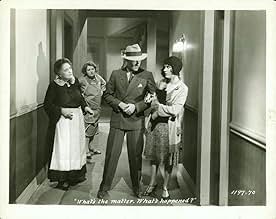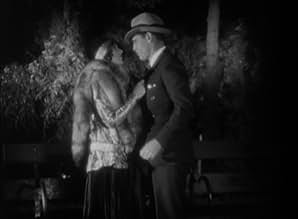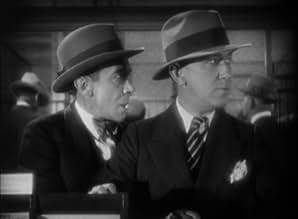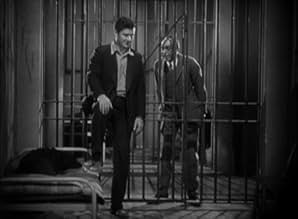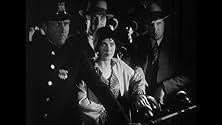VALUTAZIONE IMDb
6,5/10
995
LA TUA VALUTAZIONE
Thunderbolt, noto criminale, rischia l'esecuzione. Nella cella accanto c'è l'innocente Bob Moran, innamorato della ragazza di Thunderbolt. Questi spera di avere abbastanza tempo per poter uc... Leggi tuttoThunderbolt, noto criminale, rischia l'esecuzione. Nella cella accanto c'è l'innocente Bob Moran, innamorato della ragazza di Thunderbolt. Questi spera di avere abbastanza tempo per poter uccidere Moran.Thunderbolt, noto criminale, rischia l'esecuzione. Nella cella accanto c'è l'innocente Bob Moran, innamorato della ragazza di Thunderbolt. Questi spera di avere abbastanza tempo per poter uccidere Moran.
- Regia
- Sceneggiatura
- Star
- Candidato a 1 Oscar
- 2 vittorie e 1 candidatura in totale
Ernie Adams
- Thug in Bank at Robbery
- (non citato nei titoli originali)
Elmer Ballard
- Prisoner #8
- (non citato nei titoli originali)
Louise Beavers
- Black Cat Cafe Patron
- (non citato nei titoli originali)
Ed Brady
- Chuck - 1st Prisoner #5
- (non citato nei titoli originali)
Recensioni in evidenza
... at least for early sound. The title character in particular, Thunderbolt, played by George Bancroft, is a rather complex gangster character for a dawn of sound movie. What do you say about a man who'd go to great lengths to kill a fellow he has never met just on general principle but who loves the stray dog that causes him to finally get pinched and put in the death house to the point that when the death house warden grants him a favor, Thunderbolt asks for that same dog to stay in his cell as a pet? Fay Wray, only 21 at the time, plays Ritzy, Thunderbolt's girl, with a sense of world-weariness that is wise beyond her years. When the film opens she's being hassled by the police to give up Thunderbolt's hiding place in some really classic early sound police interrogation scenes. Ironically, she really wants to be free of Thunderbolt, who swears he'll never let her go, especially if there's another guy involved, and there is - bank teller Bob Morgan played by Richard Arlen.
The first third of the film moves about quite a bit with some great jazz age settings, but the last two-thirds is primarily confined to the death house where Thunderbolt awaits his appointment with the chair. There's lots of atmosphere in this one with the death row quartet that keeps getting broken up as one fellow is executed and then restarted as another inmate enters. The death row warden is an interesting fellow, with eccentricity and nervousness balanced by a humane streak to the point that he seems misplaced - he seems like he'd be happier managing the shoe department in some retail store.
The end has a surprise twist to it that makes Thunderbolt rethink his rather complex plan of revenge just as he makes that last walk to the chair. I'm being intentionally vague here so I don't ruin it for you. Watch it for the surprising sophistication of this early sound piece, for the kind of atmosphere you can always count on in a von Sternberg film, and for that general touch of class that you find in the early Paramount talkies.
The first third of the film moves about quite a bit with some great jazz age settings, but the last two-thirds is primarily confined to the death house where Thunderbolt awaits his appointment with the chair. There's lots of atmosphere in this one with the death row quartet that keeps getting broken up as one fellow is executed and then restarted as another inmate enters. The death row warden is an interesting fellow, with eccentricity and nervousness balanced by a humane streak to the point that he seems misplaced - he seems like he'd be happier managing the shoe department in some retail store.
The end has a surprise twist to it that makes Thunderbolt rethink his rather complex plan of revenge just as he makes that last walk to the chair. I'm being intentionally vague here so I don't ruin it for you. Watch it for the surprising sophistication of this early sound piece, for the kind of atmosphere you can always count on in a von Sternberg film, and for that general touch of class that you find in the early Paramount talkies.
Nobody would argue that 1929 was a year of classic movies. Amongst the flotsam and jetsam however there's APPLAUSE and a few other good ones..... and this as well - almost. What a difference a top director and screenwriter can make!
This isn't a gangster film, it's an intelligently written character study and in-depth look into the mind of a mobster. You find writer Jules Furthman's name on virtually every other classic Hollywood picture of the 20s, 30s and 40s. His style was quality and his skill was creating believable engaging stories with real genuine characters. His story was further adapted by H Mankiewicz - who wrote the scripts for the probably the other half of the classics from this period. Needless to say - this is well written with fascinating and deeply faceted characters.
Josef von Sternberg directed this which by the look of it was his fiftieth talkie. Surely it's impossible that this was his first sound film? Being made in 1929, it's still a little experimental, not quite everything works so this is not one of his best pictures. Nevertheless he creates a brooding almost surreal atmosphere with real tension. That style intensifies significantly in the latter part of the film on death row which has an almost dream like feel about it.
The story is tense, the characters are believable, the production is innovative but this is not a perfect film. To enable clear sound recording, some but not all of the actors speak very slowly which sounds especially weird when the actor they're talking with is speaking normally. Actors had their own individual vocal coaches then with different techniques thus the inconsistency and maybe not being a native English speaker, von Sternberg probably didn't notice the subtle differences.
As great a director as he was, von Sternberg was given the impossible task of trying to make Fay Wray seem like a proper actress. Not even he could do that and predictably she's absolutely dreadful. As always she just projects that limp, whining and insipid expression to convey whatever emotion she's trying to express.
Whether she's pretending to be a hard as nails gangster's moll or a reformed, sweet and vulnerable fragile young thing she's that same bland, shallow character. Not only can't she act but in this she doesn't appear to be able to speak English - what on earth is that accent! She's meant to be a girl from the streets so why is she doing history's worst impression of Queen Mary? That two men could be besotted with this dull sour-faced non-entity completely stretches all credibility.
This isn't a gangster film, it's an intelligently written character study and in-depth look into the mind of a mobster. You find writer Jules Furthman's name on virtually every other classic Hollywood picture of the 20s, 30s and 40s. His style was quality and his skill was creating believable engaging stories with real genuine characters. His story was further adapted by H Mankiewicz - who wrote the scripts for the probably the other half of the classics from this period. Needless to say - this is well written with fascinating and deeply faceted characters.
Josef von Sternberg directed this which by the look of it was his fiftieth talkie. Surely it's impossible that this was his first sound film? Being made in 1929, it's still a little experimental, not quite everything works so this is not one of his best pictures. Nevertheless he creates a brooding almost surreal atmosphere with real tension. That style intensifies significantly in the latter part of the film on death row which has an almost dream like feel about it.
The story is tense, the characters are believable, the production is innovative but this is not a perfect film. To enable clear sound recording, some but not all of the actors speak very slowly which sounds especially weird when the actor they're talking with is speaking normally. Actors had their own individual vocal coaches then with different techniques thus the inconsistency and maybe not being a native English speaker, von Sternberg probably didn't notice the subtle differences.
As great a director as he was, von Sternberg was given the impossible task of trying to make Fay Wray seem like a proper actress. Not even he could do that and predictably she's absolutely dreadful. As always she just projects that limp, whining and insipid expression to convey whatever emotion she's trying to express.
Whether she's pretending to be a hard as nails gangster's moll or a reformed, sweet and vulnerable fragile young thing she's that same bland, shallow character. Not only can't she act but in this she doesn't appear to be able to speak English - what on earth is that accent! She's meant to be a girl from the streets so why is she doing history's worst impression of Queen Mary? That two men could be besotted with this dull sour-faced non-entity completely stretches all credibility.
If you can get past the really rather stilted production here - almost stage bound in it's presentation, this is quite an entertaining film that sees the authorities on the trail of the most wanted "Thunderbolt" (George Bancroft). He is elusive, though - and their only route to him might be through his ex-girfriend "Ritzie" (Fay Wray) - but she isn't playing ball for reasons of her own. It's only when "Thunderbolt" makes good on an earlier threat he made to her about seeing anyone else, that the police see some light. The performances are fine, not great but the writing is really quite good - plenty of quirky vernacular and it moves along well despite the frequent silent movie style direction and scene framing from Josef von Sternberg. There is also quite an enjoyable contribution from a blues ensemble and though certainly dated, this is still worth a watch almost 100 years later.
For some reason I thought this film was a talkie remake by Josef von Sternberg of his great silent Underworld. Although George Bancroft is again the star here (and won an Oscar nomination for best actor) this is an entirely different storyline.
Bancroft stars a a tough hood in love with Fay Wray. But she's trying to go straight with Richard Arlen, who works in a bank. A man hunt captures Bancroft and convicts him to death row. But even from the cell, Bancroft is able to frame Arlen for a murder during a ban robbery. Arlen is sentenced to death row and ends up across the hall from Bancroft. Will there be fairness? Will there be redemption? As in Underworld, Bancroft is terrific as the obsessed and all-powerful thug. His voice is great as he growls and groans and threatens. Wray looks stunning, and Arlen is good as the innocent man.
For a 1929 talkie, this film has its stagnant moments when the editors didn't know when to cut. But it also features some terrific work by von Sternberg.
The entrance scene into the jazz club is a barrage of trellises and picket fences... quite beautiful... and also boasts a really nice song from Theresa Harris (who usually played a maid). There's also a wondrous scene where Arlen has been hurt and is being tended by his mother (Eugenie Besserer). While's she's applying iodine, he pulls his hands away and the bottle smashes. Both try to clean it up and the scene ends in a giggling tickle fight. Totally unexpected and totally wonderful.
Fred Kohler plays a convict. Tully Marshall is marvelous is a jittery warden.
The ending is probably expected but is beautifully done.
Bancroft stars a a tough hood in love with Fay Wray. But she's trying to go straight with Richard Arlen, who works in a bank. A man hunt captures Bancroft and convicts him to death row. But even from the cell, Bancroft is able to frame Arlen for a murder during a ban robbery. Arlen is sentenced to death row and ends up across the hall from Bancroft. Will there be fairness? Will there be redemption? As in Underworld, Bancroft is terrific as the obsessed and all-powerful thug. His voice is great as he growls and groans and threatens. Wray looks stunning, and Arlen is good as the innocent man.
For a 1929 talkie, this film has its stagnant moments when the editors didn't know when to cut. But it also features some terrific work by von Sternberg.
The entrance scene into the jazz club is a barrage of trellises and picket fences... quite beautiful... and also boasts a really nice song from Theresa Harris (who usually played a maid). There's also a wondrous scene where Arlen has been hurt and is being tended by his mother (Eugenie Besserer). While's she's applying iodine, he pulls his hands away and the bottle smashes. Both try to clean it up and the scene ends in a giggling tickle fight. Totally unexpected and totally wonderful.
Fred Kohler plays a convict. Tully Marshall is marvelous is a jittery warden.
The ending is probably expected but is beautifully done.
In 1929, talking pictures were still a novelty and some pictures in Hollywood were still coming out silent. So, it's not very surprising that this Josef von Sternberg movie comes off as a bit old fashioned. It's lack of incidental music* makes it seem a bit too quiet...but that was true of all the sound films of the day. Likewise, some of the acting is a bit stilted...and this was not at all unusual for 1929. So, I try to cut this and other movies from 1927-30 a bit of slack.
The title character, Thunderbolt Jim Lang (George Bancroft), is one of the most-wanted men in the country. He's been responsible for many bank robberies and deaths and the police are desperately searching for him. But their only lead is his old girlfriend, Ritzie (IMDB incorrectly spells it 'Ritzy' and she's played by Fay Wray). But she's sick of him and wants to go straight--and has taken up with a nice guy, Bob (Richard Arlen). But Thunderbolt has promised that if she takes up with ANYONE other than him, he'll get them...and he does this in a most peculiar way...while he's in prison! Huh? How does he do this and how does it all end? See the film and find out for yourself.
The film has some very good things going for it--particularly the mobster talk throughout the movie. It's all very tough and fun. Bancroft's performance is also quite entertaining (not necessarily GOOD but entertaining). Still, the movie's plot is very tough to believe though it is still entertaining to see today...even with its old fashioned style and bizarre scenes with Thunderbolt inexplicably in his cell with a pet dog!
*Instead of the usual background music, it's a quiet film--normal for 1929. But in all the death row scenes, there is often some sort of spiritual being sung...and wow were they annoying and overdone!
The title character, Thunderbolt Jim Lang (George Bancroft), is one of the most-wanted men in the country. He's been responsible for many bank robberies and deaths and the police are desperately searching for him. But their only lead is his old girlfriend, Ritzie (IMDB incorrectly spells it 'Ritzy' and she's played by Fay Wray). But she's sick of him and wants to go straight--and has taken up with a nice guy, Bob (Richard Arlen). But Thunderbolt has promised that if she takes up with ANYONE other than him, he'll get them...and he does this in a most peculiar way...while he's in prison! Huh? How does he do this and how does it all end? See the film and find out for yourself.
The film has some very good things going for it--particularly the mobster talk throughout the movie. It's all very tough and fun. Bancroft's performance is also quite entertaining (not necessarily GOOD but entertaining). Still, the movie's plot is very tough to believe though it is still entertaining to see today...even with its old fashioned style and bizarre scenes with Thunderbolt inexplicably in his cell with a pet dog!
*Instead of the usual background music, it's a quiet film--normal for 1929. But in all the death row scenes, there is often some sort of spiritual being sung...and wow were they annoying and overdone!
Lo sapevi?
- QuizOne of the earliest of over 700 Paramount productions, filmed between 1929 and 1949, which were sold to MCA/Universal in 1958 for television distribution, and have been owned and controlled by MCA ever since. However, because of its extreme age, and primitive sound recording techniques, there is no record of it ever having been locally televised. On cable TV it received what may have been its first and only telecast on Turner Classic Movies in August 2016.
- Versioni alternativeMade in both sound and silent versions.
I più visti
Accedi per valutare e creare un elenco di titoli salvati per ottenere consigli personalizzati
- How long is Thunderbolt?Powered by Alexa
Dettagli
- Data di uscita
- Paese di origine
- Lingua
- Celebre anche come
- Thunderbolt
- Luoghi delle riprese
- Azienda produttrice
- Vedi altri crediti dell’azienda su IMDbPro
- Tempo di esecuzione1 ora 25 minuti
- Colore
Contribuisci a questa pagina
Suggerisci una modifica o aggiungi i contenuti mancanti


